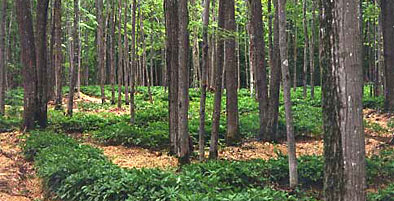Forest landowners often want to make some profit from their land, if only to pay the property taxes. Other than cutting timber, which can only be done so often, how can you generate income from your woods? In North America, our forests are often populated with a wide variety of valuable native plants and fungi that can be sustainably wild-harvested and sold. Many others can be introduced and cultivated to provide a steady stream of products to harvest for many …
YouTube Channel Wasabi Series
Wasabi is generally thought of as a pungent green paste that accompanies sushi. That green paste is more often than not, made up of grated horseradish or mustard. In this video, we take a look at the plant whose grated root makes up the real wasabi. It was traditionally eaten with sushi to combat food poisoning that can result from eating raw fish. Today, it’s considered as the natural condiment for sushi. Joe Hollis, founder of Mountain Gardens, explains what …
YouTube Channel Ostrich Fiddlehead Fern Series
University of Maine’s Agriculture and Non-Timber Forest Products Professional, David Fuller, explains what an ostrich fiddlehead looks like and how it compares with its toxic cousin, the bracken fern. When harvesting fiddleheads, it’s extremely important to choose those from the ostrich fern which are characterized by a hairless, smooth, deep green stem that has a deep groove on the inside. The fiddleheads have a brown, papery substance on the outside of the unfurled frond called ramenta. Ostrich fern fiddleheads should …
YouTube Channel Maple Syrup as a Hobby Series
Steve Caccamo, President of Next Generation Maple Products, explains how making maple syrup has become a growing hobby over the years. It’s easy to start out by tapping a few trees in your yard and boiling the sap with a turkey fryer and propane, but it is more cost efficient to use wood. We take a look at a small evaporator that Steve made for his sugar house once he decided to expand his maple syrup production.
YouTube Channel Walnut Syrup Series
Cornell University’s Director of the Uihlein Forest, Michael Farrell, explains the collection of walnut sap through vacuum tubing. Freezing temperatures in early spring cause the tree to go into negative pressure and brings water up from the ground into the tree’s cambium layer. Warming temperatures during the day cause the tree to thaw again which releases the water, now in the form of sap, back down through the cambium. It’s the freezing and thawing events that cause sap to flow …
YouTube Channel Reverse Osmosis Series
Reverse osmosis is a process that forces a solution with solvent, in this case sugar, through a membrane using a great amount of pressure. The membrane is constructed from a sheet polymer which allows water molecules to pass through while keeping the sugar molecules behind. This effectively removes much of the water from the sap and reduces the amount of boiling time and energy needed to make syrup. Steve Childs, Cornell University’s Maple Specialist explains the process of reverse osmosis …
YouTube Channel Maple Syrup Series
Late March marks the beginning of the sugar maple season in the Northeast United States. Freezing nightly temperatures followed by a daily thaw causes the rise and fall of sap within the cambium of maple trees. During the daily thaw, sap that was pulled up within the tree falls with gravity. By tapping the tree, a syrup producer is able to collect the sap that is released through the tap via pressure. Cornell University’s Director of the Uihlein Forest, Mike …
What is the difference between forest farming and wild crafting?
The two practices may produce the same products, but key differences exist between them. Forest farming is more sedentary in that it is practiced through deliberate cultivation under an established forest canopy. It requires planning, inputs, and farming activities like tilling, planting, and management. Wild crafting is more nomadic, requiring the wild crafter to search through the forest for the desired product. Consequently, finding the product, as well as the quantity of the product, is not guaranteed.
The inputs required …
Joshua Idassi- NCAT- Cooperative Extension Program
Dr. Joshua Idassi has eighteen years working with Cooperative Extension Program in the USA. Currently, Joshua, is the Natural Resources Specialist at the NCAT- Cooperative Extension Program. His responsibilities are to develop outreach and applied research in agroforestry to assist underserved and limited resources farmers and woodland owners in North Carolina establish sustainable farming practices to enhance their livelihoods. The main focus of this Agroforestry program in 2011-2015, has been to to develop educational tarining materials in agroforestry. Currently, Dr. …
Eric Norland – USDA National Institute of Food and Agriculture
Dr. Eric Norland is the National Extension Forester and National Program Leader, Forest Resource Management, at USDA National Institute of Food and Agriculture, Washington, DC. He provides leadership for forest management science and the Renewable Resources Extension Act Program. His areas of expertise are applied forest ecology, climate change effects on forest ecosystems, and adult non-formal education. Prior to joining NIFA twelve years ago, he served as County Extension Agent, District Extension Specialist, and State Extension Program Leader for Natural …
